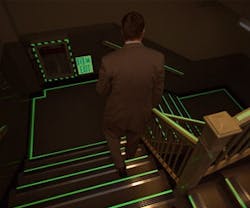Survivors who fled World Trade Center (WTC) buildings after the 9/11 terrorist attacks later told Commission investigators “the funny glowing green stuff we followed” enabled them to find their way down darkened stairwells and outside to safety.
That “funny glowing green stuff” was photoluminescent lighting – glow-in-the-dark material placed on handrails, stairs, doors, and stairwell landings. After the 1993 terrorist bombing of the WTC, the Port Authority (which managed the WTC properties at the time), installed the photoluminescent markers to aid in emergency evacuations.
Since 9/11, a number of local, state, national, and international building codes have adopted standards calling for photoluminescent lighting and exit signs to guide people to safety. “Photoluminescent technology saves lives, saves money, doesn’t use electricity, and requires no maintenance,” says Leslie Groll, president of Viviglo Technologies, Inc. and vice president of business development for GlowZone Inc.
Testimonies of photoluminescent technology by 9/11 survivors identify how safety issues can arise from failed lighting. A power outage that darkens a tall building can cause evacuees to stumble, fall, panic, and even injure themselves. It can also prevent them from reaching areas where photoluminescent markers can help. According to survivors, when the power went out, the emergency back-up batteries in the exit signs often failed. This made it difficult to see the exit signs that led to the stairwells.
Photoluminescent markers, on the other hand, aren’t compromised by power outages. Light from conventional lighting charges photoluminescent exit signs and path markers. Photoluminescent markers also identify obstructions in stairwells such as protruding pipes or storage cabinets. Should the power go off and shut down the electrical lights, photoluminescent exit signs will glow and light the way to safety.
Photoluminescent technology came of age in the mid 1990s when researchers improved the technology’s performance with strontium oxide aluminate pigment. The new pigment produced a brighter photoluminescent glow, making the lights easier to see under adverse conditions. The pigment can also be added as an ingredient to ceramic, paint, plastic, tape, and other materials.
In 2004, New York City adopted a building code standard requiring photoluminescent markings along exit paths in all commercial buildings 75 feet tall and higher. The standard also requires exit signs made of photoluminescent material. The 2009 edition of the International Building Code adopted a similar standard.
According to the Photoluminescent Safety Association, a number of other organizations that issue building codes also require photo-luminescent markings. These include the National Fire Protection Association (NFPA), California, Connecticut, and the General Services Administration (GSA).
NFPA, for example, recommends illuminating the face of exit signs with an appropriate charging light source, which is charged when the building is occupied and regulated by authorized personnel. The signs should also be located so they can be seen from 50 to 75 feet away, their recommended viewing distance.
Groll says that the Federal Aviation Administration approved photoluminescent escape-path markings in the late 1990s. According to the Flight Safety Foundation, the airline industry embraced the change, installing the technology in more than 4,600 aircraft operating by airlines around the world by 2004. “More recently, in 2006, the American Public Transit Association, in response to a train wreck, set guidelines to install photoluminescent pathway markings,” Groll adds.
Some local jurisdictions are using incentives instead of regulations to implement photoluminescent exit path systems. The Ccity of Anaheim, CA, for instance, will pay half of the installed cost – or $30 per fixture, whichever is less –up to $10,000 for commercial building owners and industrial electric customers to install photoluminescent exit signs. While owners are still responsible for purchasing path markers, photoluminescent exit signs will help eliminate the type of disorientation that 9/11 evacuees experienced.
“A building owner that replaces 100 signs would receive $3,000 in incentive payments,” Groll says. “In addition, you won’t have to buy electricity to power the photoluminescent exit signs. That could save you another $3,000 per year.”
Light emitting diode (LED) exit signs are also included in the program. Though LED signs use less electricity than conventional signs, photoluminescent systems draw no electricity, making them virtually fail-safe in an emergency.
In the end, “funny glowing green stuff” costs little to install, nothing to operate, and nothing to maintain – it saves your budget, the environment, and your personnel.
